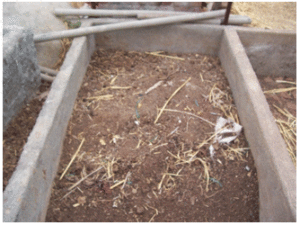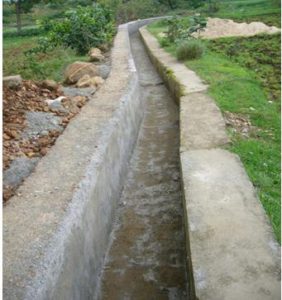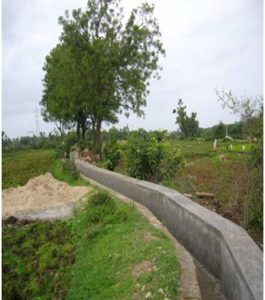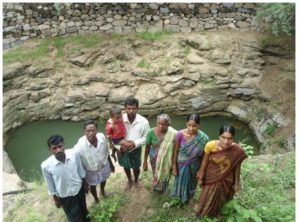YFA works in rainfed eco-systems which provides food and employment to more than 60% of India’s population. In the recent period the agriculture sector and farmers experienced severe agrarian crisis due to poor public and private investments resulting in falling agriculture GDP. The country has also experienced large number of farmers suicides which resulted in multiple burden on women and children. The Government in the new budget emphasised on empowering farming community and also the sustainable development goal 1, 2, 10, 13 and 15 aimed at addressing the multiple issues faced by the farming communities. Responding to the needs of farmers YFA adopted variousmeasures of Watershed approach to bring overall development of land, water, vegetation and livelihoods. Gender and women’s participation is the top most consideration for any NRM project of YFA and hence, Government of India (ICAR) has awarded KVK scheme to YFA to further advance the Interest of dryland agriculture and women farmers. Few case studies of our work is described below:
Case studies:
Q.YFA: Nagamma tell us how this red-hairy caterpillar (Bontapurugu) programme initiated:
Nagamma: YFA sir’s organized several meetings in the village and also with us. Men though wat these women can do and why they have been invited when we men farmers have failed to control the pest so many times in the past through spraying chemicals. However, finally, we have been given training on “Group work” as they pest emerges during the first and second heavy rains. Therefore, it was necessary to organise groupings based on the contiguous plots of land within the village boundaries as pest can also re-attack from the other plots as it can walk faster, once it is totally matured. Hence, the idea was to control it during the initial stage and if here is anything remaining then adopt other methods of control. So it was really a team work within the village.
Q.YFA: You told, other methods what were those?
Nagamma: Apart from monitoring and emergence of moth at the light traps, we have also used mixed cropping of castor and cucumber to attract the caterpillar, spread calotrophis, jatropha, Ipomea twigs (BesharamAkulu) around the RHC (valuable) fields and trapped caterpillars which were then killed by school children to whom we water to expose them such realities. Such actions were organized on more than 500 ha of land including the outside village boundaries.
Q. YFA: What kind of training organized by KVK Sir (Sir’s the way members address YFA/KVK staff) and what benefit occurred?
Members: It was extremely good to seed pictures on charts and posters identifying the physical characters of the pest from the initial stages. It was highly helpful in identifying the correct timings of emergence and more specifically, the follow-up support provided by the extension staff.
Concerning to benefit, we have saved the crop damages at least to the tune of Rs.2500-3000/ha and we treat this as direct benefit but indirectly the skills provided to us empowered me and my colleagues in women sangha and liberated me from the traditional outlook towards my life. Today, the men and women listen to each other. On the other hand, seeing our experience many of the other villages have initiated their own programme and benefiting from it. Such programmes are quite useful in our life.
YFA: Thank you very much, Nagaamma.
YFA/KVK conducted another experiment in Rajapet village with women farmers of sangha. The experiments was planned for introduction of age old traditional organic farming systems called Vanapamulu (Vermiculture). The women members have also invited the men farmers and initiated the discussions around a) how much fertilizer/used for nitrogen fixation on various crops, particularly on mango orchards b) the finances spent on the fertilizers c) labour d) ecological degradation e) insufficient nutrition to soils etc.,
After careful analysis it was agreed by the members that 15 of them will get training in starting a vermiculture unit in the village. Thus, the training strategy adopted was “hands on experience” in nature and conducted in the village. Today, Uttaramma when imparting training to new village members of Tumpally, Nacharampet, etc., and explain that,
-Prepare a bet at about 3ft x 12ft.
-Put soil wastes etc.
-Cover it with sunny bags and regularly sprinkle water. This is very simple and easy and one can get an NPK value of 0.75-10.65 (of course, the explanations were in local dialect in nature) and through vermicompost of 4 q in the first month. This is extremely useful in food production; resistance to pest and disease attacks; availability of balanced nutrients; reclamation of waste lands etc., On the other hand, YFA/KVK through such a trial arranged earth worms (Eseniafeotida) essential for preparation of vermicompost; organized planning and training; and finally the technical skills to women members and master trainers. Such an experience highlights the fact that a) Agriculture is always been a joint activity within a family and hence, do not ignore women farmer b) if we make concreted efforts the results will be multiple c) it empowers women within our society d) benefits were shared more equally e) ecological conditions were met.
On the other hand, YFA/KVK through such a trial arranged earth worms (Eseniafeotida) essential for preparation of vermicompost; organized planning and training; and finally the technical skills to women members and master trainers. Such an experience highlights the fact that a) Agriculture is always been a joint activity within a family and hence, do not ignore women farmer b) if we make concreted efforts the results will be multiple c) it empowers women within our society d) benefits were shared more equally e) ecological conditions were met.
Finally, when we questioned the monetary benefits the women told us that by way selling the compost they could earn about Rs.2600 within 3-6 months and farmers could save by using vermicompost for horticulture nursery and bio-intensive gardens at the tune of average Rs.2500/year/ha of land/farmer.
Farmers are the managers of the locally designed Canal system in Kakalwar village-An example of participatory irrigation management.
Rationale:
The national policy on water particularly for irrigation recommended for involvement of farmers both in maintenance, distribution and management. It was highlighted in the policy that the public institutions must focus on improving the management of water at the main system level. Farmers who depend on irrigation water for their livelihoods have the strongest incentive to manage that water very carefully. No public sector agency could match the discipline that farmers impose on themselves when they manage their own irrigation system.
Existing situation in Kakalwar village:
The Kakalwar village represents a semi-arid situation where farmers mostly depend on rainfed dryland agriculture. The irrigation needs of the village is typically served by a traditional tank and irrigates about more than 300 acres of land in its command area. The waist weir including the canal system used to be managed by the elders of the village but slowly such system is replaced by the government agency about two decades ago. The irrigation department took over the reconstruction of waist weir including the sluice and canal system for distribution of water. This process of taken over from the traditional management resulted in poor participation of farmers both in management and maintenance of the structure. The farmers of the village led by Mr.Allabaksh the secretary of SujalSamithi and also a panchayat member informed in one of the meetings that the tank is heavily silted and the canal system in the command area is not functioning properly as the government irrigation department is not responding to the requests of farmers for de-siltation and repair. Today the tank could only irrigate about 25% of its capacity.
The approach of participatory irrigation management:
YFA is implementing an innovative model of involving farmers and panchayat to bring equity and management of water resources by people’s institutions. It was recognised that the inefficiency of the public administration and the market failure in managing water resources, demand new organising and people managed systems to improve the performance. Users involvement in managing water resources is the most suitable solution to this kind of problems.
The Process: YFA while preparing a detailed water plans with people and panchayat discovered that the traditional tank provides not only irrigation but also assures food security of the people and also productive employment. The people identified the repair and de-siltation of the tank as one of the major priority. Several discussions and consultations led to establish a SujalSamithi to take all the decisions pertaining to village priorities. Panchayat of Kakalwar village has become a true partner in the process. The transact walks revealed the extent of damage occurred with respect to side walls of the canal structure including the walls of the canal structure including the leakage at the sluice. The members of the Samithi informed that the tank bed had a depth of 8-12 fts but now it is only about 6 fts.Its catchment area is degraded and devoid of top soil and vegetation. This means the massive erosion of fertile soil and it must have affected the productivity of the agriculture lands in its catchment and at the same time reduced water holding capacity of the tank. SujalSamithi together with panchayat calculated that the Canal repair requires re-construction of side walls to the extent of 2.5 kms from its source. the members of the SujalSamithi were motivated by YFA to approach irrigation department through panchayat for financing. YFA employed its agriculture and consulting civil engineer for preparation of technical and financial plan. The budget for canal repair estimated around Rs.300000 and for de-siltation and repair of side walls of the waist weir and sluice was Rs.50000 The plans then were submitted to irrigation department for financing which was refused by the department verbally informing that they would prepare a budget based on the guidelines prescribed by the irrigation department but may take longer time. Frustrated over this development the people approached YFA for the support. YFA based on the discussions has agreed to contribute to the extent of 62% based on the revised budget planned by the SujalSamithi. It took nearly 2 months to complete all the works of canal repair, side wall construction and de-siltation of the tank.
YFA while preparing a detailed water plans with people and panchayat discovered that the traditional tank provides not only irrigation but also assures food security of the people and also productive employment. The people identified the repair and de-siltation of the tank as one of the major priority. Several discussions and consultations led to establish a SujalSamithi to take all the decisions pertaining to village priorities. Panchayat of Kakalwar village has become a true partner in the process. The transact walks revealed the extent of damage occurred with respect to side walls of the canal structure including the walls of the canal structure including the leakage at the sluice. The members of the Samithi informed that the tank bed had a depth of 8-12 fts but now it is only about 6 fts.Its catchment area is degraded and devoid of top soil and vegetation. This means the massive erosion of fertile soil and it must have affected the productivity of the agriculture lands in its catchment and at the same time reduced water holding capacity of the tank. SujalSamithi together with panchayat calculated that the Canal repair requires re-construction of side walls to the extent of 2.5 kms from its source. the members of the SujalSamithi were motivated by YFA to approach irrigation department through panchayat for financing. YFA employed its agriculture and consulting civil engineer for preparation of technical and financial plan. The budget for canal repair estimated around Rs.300000 and for de-siltation and repair of side walls of the waist weir and sluice was Rs.50000 The plans then were submitted to irrigation department for financing which was refused by the department verbally informing that they would prepare a budget based on the guidelines prescribed by the irrigation department but may take longer time. Frustrated over this development the people approached YFA for the support. YFA based on the discussions has agreed to contribute to the extent of 62% based on the revised budget planned by the SujalSamithi. It took nearly 2 months to complete all the works of canal repair, side wall construction and de-siltation of the tank.
The Change: The work created both short term and long term livelihoods in addition to conservation and better utilisation of precious water resources. The farmers informed that earlier the water availability in the tank was about for 12-20 days but now after the repair the water is available for about 35 days. Secondly, due to leaks in the canal lines the water gets used to be wasted. Now the cemented canal work reduced such water waste and reaches to the targeted farmer’s fields. Earlier the faulty canal system could irrigation about 40 acres and now it irrigates more than 200 acres which is about more than 400% of its earlier levels. The crop cultivation multiplied from single crop to multiple crops and increased productivity. The conserved water has also created sustainable employment and attained economic empowerment of farmers wherein they take the decision pertaining to water use, distribution, crop planning and maintenance. The assured food and nutritional security of each participant family has resulted in better health attained by women and children.
The work created both short term and long term livelihoods in addition to conservation and better utilisation of precious water resources. The farmers informed that earlier the water availability in the tank was about for 12-20 days but now after the repair the water is available for about 35 days. Secondly, due to leaks in the canal lines the water gets used to be wasted. Now the cemented canal work reduced such water waste and reaches to the targeted farmer’s fields. Earlier the faulty canal system could irrigation about 40 acres and now it irrigates more than 200 acres which is about more than 400% of its earlier levels. The crop cultivation multiplied from single crop to multiple crops and increased productivity. The conserved water has also created sustainable employment and attained economic empowerment of farmers wherein they take the decision pertaining to water use, distribution, crop planning and maintenance. The assured food and nutritional security of each participant family has resulted in better health attained by women and children.
The lessons learned through participatory process:
The participatory process assured equity in sharing of costs and benefits as explained earlier by all the stakeholders involved. The involvement of people assured the transparent implementation of people’s water plan otherwise government agencies would have abandoned due to this inherent heavy budget required for the purpose. The low cost model found to be acceptable by people and hence, the sharing of resources could be achieved.
The social capital in a form of collective action undertaken through SujalSamithi for managing their traditional irrigation systems constitute a form of social capital that can have spinoff effects in other aspects of social and economic life. The network of contacts with government agencies, the leadership of panchayat and SujalSamithi can bring the stakeholders into closure touch with other related services of credit and training opportunities. The skills the farmers of the SujalSamithi learned through their experience with the tank workin accounting, budgeting, planning, organising constitute a set of knowledge that can be used in many other productive endeavours.
Efficiency:
Efficiency occurs when management is decentralised to users and they can respond more quickly to problems or changes in the system required. Government run systems are chronically short of maintenance funds leading to deteriorating the infrastructure. Management transfer of maintenance linked to farmers livelihoods offers an efficient system of natural resources management. The case of Kakalwar village depicts such efficiency for water management in the region. The users have stronger incentives to manage water productively than a government agency.
De-siltation of community irrigation wells:
Once upon a time the Mahabubnagar district was ruled under Nizam Kingdom. During those ancient years the strategy of the local Tahsildars / Aasthandars (representatives of Nizam) used to construct small traditional tanks and wells to counter the drought conditions. Learning from this strategy the earlier Governments particularly during the times of Prime Minister Indira Grandhi a massive well development programme was promoted. Many of these wells promoted during those years used to be community in nature and over a period of time the new generation found to be more individual family oriented rather than leading a community life. These abandoned community wells have water but it required community collaboration to clean up the silt deposited upto 10-14 fts. The cleaning up operations would demand upto Rs.16000-20000 and also community labour. The expenditure is generally towards hiring labour, motor and a crane to lift the soil as it can’t be lifted by human labour from such huge depth of 80-120 fts. The deepening of community irrigation wells can be an example of mitigation and adaptation for climate work, for example the lifting of soil, carrying it to the field generates immediate employment to women and men of the village and cleaning of the silt would act as rejuvenating ground water and also harvest of surface water through making a channel from the high elevated point of the particular field. Keeping in view of the drought conditions YFA initiated the activity.
 Deepening of well changed our life- say Lakshmi of Vallabapur china thanda.
Deepening of well changed our life- say Lakshmi of Vallabapur china thanda.
We are a joint family constituting of 4 brothers. As a tribal family we also cultivate our lands collectively. We had one community well but the well water was not utilized as the well needed de-siltation and deepening. Due to shortage of employment and agriculture productivity two of our families used to migrate to Mumbai after taking some advance from the local contractors. Along with us our children also migrate and many of times we feel sorry that they led a horrible life and discontinued their education. We used to feel bad that we could not provide sufficient support for their health and nutrition. In such situation the sangha and YFA organized meetings with our sangha and in one of those meetings I requested for rejuvenating our well. Accordingly, the sangha and YFA agreed to provide the support for crane and we 4 families have agreed to provide labour. We worked on these well continuously for 11 days and today we got enough water to cultivate crops. We have sown groundnut, and vegetables mobilizing the crop loan from the local bank which resulted in getting about Rs.16000/ in cash income on our 3 acres and also food sufficient for our family members. The deepening of well has resulted in controlling our migration and hopefully by next season we will be able to send our children to school. Meanwhile, we sincerely thank AH/YFA for the assistance.
Case Study: Chennamma, Gundamma and Kalavathamma are the members of sangha in Busireddypalli village. Each one of them have about 1.2-1.5 acres of dry land. These lands are situated adjoining to each other and about 20 years ago their families dug a common irrigation well. But unfortunately the yield was not sufficient and over a period of time this well was abandoned. The well has then become filled with silt and boulders even though some potentials of water was existing. During one of the field visits by YFA team discovered the well and some discussions with women members in the sangha revealed that such good water resource could not be used. The families of Chennamma, Gundamma and Kalavathamma used to migrate during the non-agriculture season to supplement their income. When the issue of using the community irrigation wellcame up these women said that they would like to use the resource provided some help is extended by YFA as the families are not in a position to invest for the de-siltation work. After having several discussions on water sharing and crop planning it was decided by the sangha to assist these 3 families for de-siltation work. YFA on its part provided Rs.8400/- for hiring a crane and the 3 families provided voluntary labour 72 wo(man) days. Today the abandoned well has enough water to irrigate 1.5 acres of land (1/2 each of 3 families) and a first crop of vegetables and redgram would be harvested by mid October 2015. It is estimated that the activity has created that women 72wo(man) days at the same time would bring Rs. 5000/each as cash income. The 3 families would also consume 10-15kgs of pulses, about 10 kg of vegetable enhancing the nutritional status and providing food security of these 3 poor families in the conditions of prevailing drought. Chennamma, Gundamma and Kalavathamma extends their sincere thanks to YFA for the assistance and further said that the activity stopped their migrated otherwise by this time they would have migrates to Hyderabad in search of food and employment.
Chennamma, Gundamma and Kalavathamma are the members of sangha in Busireddypalli village. Each one of them have about 1.2-1.5 acres of dry land. These lands are situated adjoining to each other and about 20 years ago their families dug a common irrigation well. But unfortunately the yield was not sufficient and over a period of time this well was abandoned. The well has then become filled with silt and boulders even though some potentials of water was existing. During one of the field visits by YFA team discovered the well and some discussions with women members in the sangha revealed that such good water resource could not be used. The families of Chennamma, Gundamma and Kalavathamma used to migrate during the non-agriculture season to supplement their income. When the issue of using the community irrigation wellcame up these women said that they would like to use the resource provided some help is extended by YFA as the families are not in a position to invest for the de-siltation work. After having several discussions on water sharing and crop planning it was decided by the sangha to assist these 3 families for de-siltation work. YFA on its part provided Rs.8400/- for hiring a crane and the 3 families provided voluntary labour 72 wo(man) days. Today the abandoned well has enough water to irrigate 1.5 acres of land (1/2 each of 3 families) and a first crop of vegetables and redgram would be harvested by mid October 2015. It is estimated that the activity has created that women 72wo(man) days at the same time would bring Rs. 5000/each as cash income. The 3 families would also consume 10-15kgs of pulses, about 10 kg of vegetable enhancing the nutritional status and providing food security of these 3 poor families in the conditions of prevailing drought. Chennamma, Gundamma and Kalavathamma extends their sincere thanks to YFA for the assistance and further said that the activity stopped their migrated otherwise by this time they would have migrates to Hyderabad in search of food and employment.
